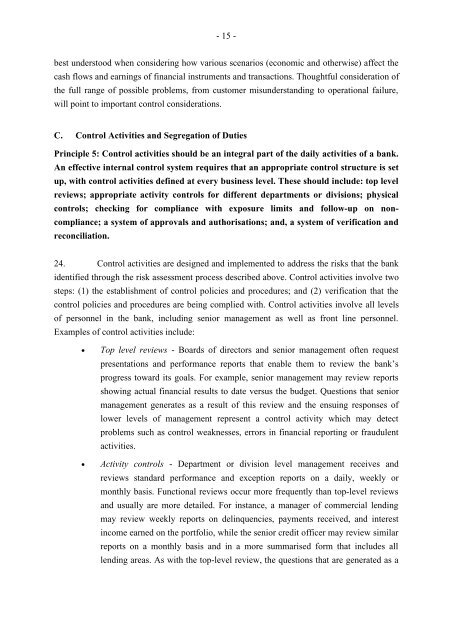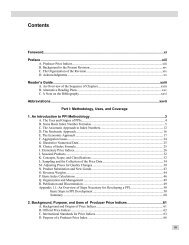Framework for Internal Control Systems in Banking Organisations
Framework for Internal Control Systems in Banking Organisations
Framework for Internal Control Systems in Banking Organisations
Create successful ePaper yourself
Turn your PDF publications into a flip-book with our unique Google optimized e-Paper software.
- 15 -<br />
best understood when consider<strong>in</strong>g how various scenarios (economic and otherwise) affect the<br />
cash flows and earn<strong>in</strong>gs of f<strong>in</strong>ancial <strong>in</strong>struments and transactions. Thoughtful consideration of<br />
the full range of possible problems, from customer misunderstand<strong>in</strong>g to operational failure,<br />
will po<strong>in</strong>t to important control considerations.<br />
C. <strong>Control</strong> Activities and Segregation of Duties<br />
Pr<strong>in</strong>ciple 5: <strong>Control</strong> activities should be an <strong>in</strong>tegral part of the daily activities of a bank.<br />
An effective <strong>in</strong>ternal control system requires that an appropriate control structure is set<br />
up, with control activities def<strong>in</strong>ed at every bus<strong>in</strong>ess level. These should <strong>in</strong>clude: top level<br />
reviews; appropriate activity controls <strong>for</strong> different departments or divisions; physical<br />
controls; check<strong>in</strong>g <strong>for</strong> compliance with exposure limits and follow-up on noncompliance;<br />
a system of approvals and authorisations; and, a system of verification and<br />
reconciliation.<br />
24. <strong>Control</strong> activities are designed and implemented to address the risks that the bank<br />
identified through the risk assessment process described above. <strong>Control</strong> activities <strong>in</strong>volve two<br />
steps: (1) the establishment of control policies and procedures; and (2) verification that the<br />
control policies and procedures are be<strong>in</strong>g complied with. <strong>Control</strong> activities <strong>in</strong>volve all levels<br />
of personnel <strong>in</strong> the bank, <strong>in</strong>clud<strong>in</strong>g senior management as well as front l<strong>in</strong>e personnel.<br />
Examples of control activities <strong>in</strong>clude:<br />
• Top level reviews - Boards of directors and senior management often request<br />
presentations and per<strong>for</strong>mance reports that enable them to review the bank’s<br />
progress toward its goals. For example, senior management may review reports<br />
show<strong>in</strong>g actual f<strong>in</strong>ancial results to date versus the budget. Questions that senior<br />
management generates as a result of this review and the ensu<strong>in</strong>g responses of<br />
lower levels of management represent a control activity which may detect<br />
problems such as control weaknesses, errors <strong>in</strong> f<strong>in</strong>ancial report<strong>in</strong>g or fraudulent<br />
activities.<br />
• Activity controls - Department or division level management receives and<br />
reviews standard per<strong>for</strong>mance and exception reports on a daily, weekly or<br />
monthly basis. Functional reviews occur more frequently than top-level reviews<br />
and usually are more detailed. For <strong>in</strong>stance, a manager of commercial lend<strong>in</strong>g<br />
may review weekly reports on del<strong>in</strong>quencies, payments received, and <strong>in</strong>terest<br />
<strong>in</strong>come earned on the portfolio, while the senior credit officer may review similar<br />
reports on a monthly basis and <strong>in</strong> a more summarised <strong>for</strong>m that <strong>in</strong>cludes all<br />
lend<strong>in</strong>g areas. As with the top-level review, the questions that are generated as a
















